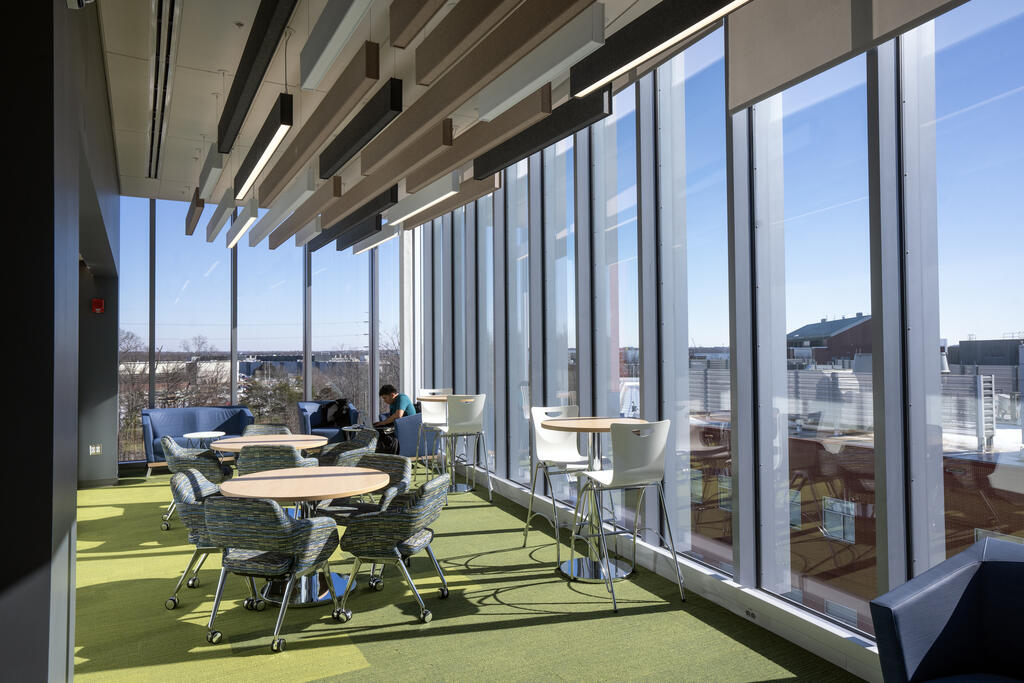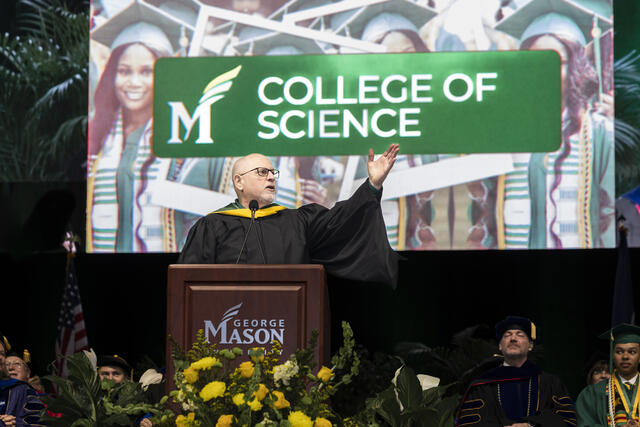Admission CTAs
Dean’s blog: Know where we’ve been
Some say, to know where you are going, you must appreciate where you’ve been. As we finalize our strategic plan to take Mason Science forward for the next five years, I think it is helpful to also understand and appreciate our college’s history, as shared by someone who lived it.
This spring 2023, we were fortunate to have Mark Monson, the College’s most recent Distinguished Alumni award winner, speak as keynote at our Degree Celebration. Mark leveraged the biology undergraduate degree he received from Mason fifty years ago as the foundation for an illustrious career in public health and administration and is the embodiment of Patriot Pride that we encourage our graduates to cultivate.
An extremely committed active Mason alumnus, he currently serves as President of our college’s alumni chapter and generously shares his time, talent, and financial support. Over the years, Mark has attended college outreach events and established endowments including a scholarship for biology majors; a scholarship for visual arts majors in honor of his late wife Nancy; and an endowment supporting the athletic academic support center. He is the first of eight in his extended family who are Mason alumni, including his brother and his first wife, his two children and their spouses, and his stepdaughter. Now that’s a family who knows to wear green and gold on Fridays!
I’ve included some excerpts from his speech as I thought you might find it interesting to see Mason Science from his point of view.
“Fifty years ago, I was sitting where you are now, getting ready to graduate from Mason with a BS in biology and contemplating my future. As y’all get ready to move to the next chapters of your life stories, I thought it would be helpful to try to put today in some perspective. To do that, let me take you back to when George Mason, and I, were still very young.
When I started at Mason in 1969, the campus consisted of 6 buildings – the North, South, East, and West buildings (around the original quad), the library (just the 2-story part), and the lecture hall. The rest of campus – everything, and I do mean everything – was all woods.
The total student body was about 1,500 students and there were no dorms; everyone commuted.
What is now the Field House and the playing fields was an abandoned farm. There were no SciTech or Arlington campuses. No Potomac Science Center. Mason’s campus in South Korea hadn’t even been thought of yet. We didn’t even have a place for our basketball team to play. Until the PE building was built in 1972, we had to play our home basketball games at local high school gyms.
George Mason College was a tiny, 6-building campus in a clearing carved out of several hundred acres of woods here in Fairfax.
The only way to get onto campus was from University Drive. Both Braddock Road and Ox Road (Route 123) were 2 lanes – not much more than country roads. In fact, there was no traffic light at the intersection of Braddock and 123 my freshman year. Just a stop sign. Neither Braddock Road nor 123 had an entrance to campus. Nor was there one from Roberts Road. The only entrance was off University Drive, and it led to the one and only parking lot on campus, located in the area where Merten Hall is now.
In those days, Mason had only 5 undergraduate science degrees: A BA and BS in Biology, and BAs in Chemistry, Math, and Physics. That’s it. There were no graduate degrees.
The facilities back then were pretty sparse compared to today. The chemistry classrooms and labs were on the top floor of the South Building (now called Krug Hall) and the biology classrooms and labs were on the ground floor. Math, physics, and our computer link to UVA in Charlottesville were in the West Building.
Today, Mason’s College of Science occupies multiple buildings on all campuses: Fairfax, SciTech, the Potomac Science Center, and on Mason’s South Korea campus, with classroom and laboratory space for state-of-the-art, cutting-edge research, teaching, and study. Mason Science now has 12 distinct science programs offering 84 different degrees. There are undergraduate degrees in 19 majors and 28 minors; plus 15 masters degrees, 11 PhD degrees, and 11 Graduate Certificates. A tad different than the 5 in my day.
In some respects, being a student 50 years ago was not that much different than it is today…
Studying for tests, writing papers, spending countless hours conducting lab experiments and exercises, and then having to write them up. Loving some classes, like Genetics and Algae and Fungi; hating others, like English Composition and Organic Chemistry. Having to get up at the crack of dawn to make it to campus for a 7:30 a.m. Monday morning Spanish lab.
In many other respects, however, life as a Mason student in my day was very different than today.
As I said, we were a small school and there were no dorms. Everyone commuted. As a result, there was no campus life as you think of it today. There was no University Life office.
No Johnson Center, no HUB, no dining hall, and no Starbucks or fast-food places. No University Mall across the street. The only place on campus for us to gather and eat was a cafeteria in the basement of the South building, which we called the Ordinary, from a Colonial Period word referring to an inn or tavern.
Except for the Library, which stayed open to 9:00 or 10:00 on weekdays (and maybe 6:00 or so on weekends), pretty much everything closed up when classes were done for the day, maybe 5:00. Most students worked; a fair number worked full-time. Which meant that folks came to class and then left, leaving campus effectively deserted by dinner time. Pretty much the only social life that I can remember was through the Greek organizations. There were two fraternities and three sororities and I vaguely recall a few other student organizations, like the chess and astronomy clubs.
While many of the courses offered back then had the same titles as they do today, the advances in the scientific disciplines make the material being taught today vastly different.
Take DNA for example. About 1971 or ’72, Mason hired its first biochemist, Dr. Gene Yonashot. Dr Y’s area of research was DNA – the first DNA research at Mason. Dr. Y got his DNA from rat livers.
I was a student assistant in the chemistry department at the time and I happened to be working in the lab one day when Dr. Y was on the last step of the extraction process and asked me to help.
He had a small beaker with some residue in the bottom. He took a sterile glass rod and put one end in the beaker and started slowly twirling it. As he twirled the glass rod, I slowly decanted grain alcohol into the beaker. Strands of DNA wrapped around the glass rod like translucent spaghetti. It was just about the most amazing thing I had ever seen. Right here, in a lab in the chemistry department of George Mason College, DNA was being extracted like magic! … I can still picture it in my head like it was yesterday... What was then an awe-inspiring event, is today, I’ve been told, a common lab exercise in basic biology.
Scientists have mapped the human genome and are today using DNA to help solve crimes and find a cure for cancer… From astronomy and astrophysics to quantum mathematics to cellular biology to nanoparticles to film-based fluorescent sensors; in the 50 years since I graduated college, advances in
scientific knowledge have taken us places that were then only the imaginings of science fiction writers.You are beneficiaries of and participants in this amazing progression of scientific endeavor. Your degree from Mason will enable you to enter careers that will lead to discoveries that will take us places we only dream of today.
Y’all are part of a legacy that started in 1957 as a branch campus of the University of Virginia with 17 students in a single building in Bailey’s Crossroads. From that inauspicious start 66 years ago, George Mason University has grown into an R1 research institution of about 40,000 students (almost 7,000 living on campus, some in our college-supported learning communities) with campuses throughout Northern Virginia and in South Korea, and almost 230,000 alumni.
Mason graduates are among the most creative, innovative, and inventive alumni anywhere. And you are part of that. I am absolutely convinced that you will make a difference in the world.”
I would also add our staff and faculty to that list as well. I am grateful for Mark’s remarks and advocacy to help us reflect on where we’ve been. I know with certainty, as we move forward with our college’s strategic plan that we too will continue to make a difference, both in the world at large, and just as importantly, in the lives of the students and members of the communities we serve.
Thank you all for your efforts to bring the Class of 2023 to graduation. Our Mason Science community persevered through COVID learning and members of this class are a shining example of why we do what we do every day.
FMW

